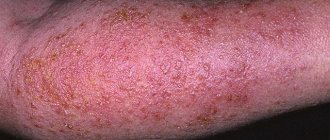One of the most common dermatological diseases is eczema; it affects about 10% of people on earth. This is the name given to the inflammatory process of the superficial layers of the skin, which is prone to a chronic, relapsing course and has gradual alternating polymorphic symptoms. The disease is not contagious, but people around them often avoid people with lesions on open areas of the body. Treatment of chronic eczema should include local and systemic effects on the disease.
…
Chronic eczema
Chronic eczema is usually the final stage of an acute inflammatory skin disease. Once having discovered the characteristic symptoms of the disease - skin inflammation, blisters, itching - a person must realize that it will not be so easy to get rid of the unwanted guest. Therapeutic measures taken during the acute phase of the disease help put eczema into a dormant state. Now is the time to reconsider your previous lifestyle and make the necessary changes so as not to “wake up” the guest.
Causes
Dermatitis can be triggered by both external irritants and serious diseases. It is the doctor’s task to look for the cause, but you can find out what common reasons the mentioned types of eczema occur:
- Mycotic. The trigger is allergic reactions to various fungal infections.
- Professional. Exposure to pathogenic factors of production, contact with chemicals.
- Varicose. The disease occurs in people with chronic varicose veins.
- Eczema of the nipples. A consequence of improper breastfeeding, one of the complications of scabies.
- Sycozyform eczema. Occurs due to microtraumas, chronic rhinitis, improper hair removal, etc.
To date, not all causes of the development of dermatitis have been established. The appearance of eczema can be influenced by disruptions of the nervous system, the development of endocrine and metabolic pathologies, a weak immune system and genetic factors, excess weight (varicose eczema), pregnancy and limb injuries. Infections and allergies play an important role in the formation of non-contagious inflammatory diseases.
Stages of development
Like any disease, idiopathic eczema has several stages of evolution. It all depends on the general health of the person, as well as on external and internal irritating factors.
- Spicy. The stage is characterized by intense redness of the skin and the appearance of slight swelling in the affected areas. Small bubbles appear that often burst. If treatment is not carried out, then after two months the stage moves to the next level.
- Subacute. All signs of the previous stage are smoothed out, and in places of inflammation, the dermis thickens. The process lasts approximately six months.
- Chronic. The affected area is covered with scales; to the touch there is thin, rough skin with a dull color. Without medical assistance, the stage lasts for a very long time, either fading or intensifying.
Periodic exacerbation of the disease against the background of a viral infection or hypothermia provokes the emergence of new foci of inflammation. Dried dermis often cracks, resulting in bleeding wounds. Hard, calloused areas appear on the hands and soles.
The chronic stage is characterized by thin and pale skin
Forms of the disease
The following forms of pathology are distinguished depending on the main cause of its development and clinical signs:
- True. Usually affects the skin of the face and hands.
- Pruriginous. With this form, the formation of papules and vesicles on the skin is observed.
- Dyshidrotic. It is considered one of the types of true eczema.
- Allergic. Occurs when an allergen acts on the body.
- Atopic. It often appears in childhood and is severe.
- Professional. Develops due to constant contact of an employee with chemical components.
- Bacterial. Appears when the inflammatory process on the skin is complicated by the addition of a microbial infection.











